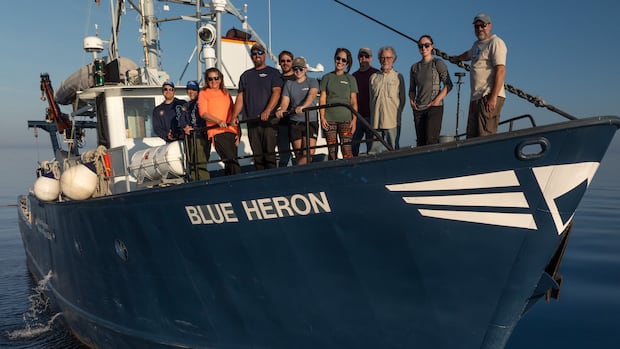Science
Research Team Explores Superior Shoal to Uncover Ecosystem Secrets

The Superior Shoal, an underwater mountain rising nearly 300 metres from the depths of Lake Superior, is gaining attention as researchers investigate its role in the lake’s ecosystem. Located 70 kilometres from the nearest shoreline, this submerged geological feature has remained largely unexplored since it was first charted in 1929.
A research team from Lakehead University in Thunder Bay, Ontario, recently embarked on a nine-day expedition aboard the research vessel Blue Heron. Their mission, which began in early September 2023, aimed to gather crucial data on how the shoal influences the local aquatic environment.
Research Focused on Ecosystem Dynamics
According to Michael Rennie, an associate professor at Lakehead University and a research fellow at the International Institute for Sustainable Development-Experimental Lakes area, the Superior Shoal presents a unique opportunity to study the interactions between physical processes and biological communities. “This is such a unique spot,” Rennie stated. “There are a couple of other spots like this throughout the Great Lakes, and what we’ve sort of come to learn is much like seamounts in the oceans, these are hotspots of biodiversity and fish productivity.”
The team, supported by a Canadian government grant, undertook various tasks to understand how currents, waves, and light penetration affect the biological community residing in the shoal. Rennie emphasized the significance of these physical processes, noting that they may support fish populations crucial to the health of Lake Superior’s ecosystem.
The expedition members aimed to assess the impact of these interactions on the trout fishery within Lake Superior, particularly the unique strains of lake trout, including redfin, leans, and siscowet, that thrive in this area. “These places like Superior Shoal, no one ever stocked fish there,” Rennie explained. “And those populations have recovered more or less on their own.”
Documenting the Expedition
Alongside the scientific exploration, filmmakers from Inspired Planet Productions captured the expedition for a new documentary series. Yvonne Drebert and Zach Melnich, both fellows with the Royal Canadian Geographical Society, expressed enthusiasm about documenting an area rarely explored on camera.
Melnich described their interest in the shoal, which was sparked by their previous work on a documentary that examined the ecological impact of invasive species in the Great Lakes. “We basically begged Michael to take us,” he said, highlighting their desire to film the unique biodiversity of the region.
The filmmakers utilized a high-tech underwater robot, or remotely operated vehicle (ROV), to capture footage at depths of up to 500 metres. This 27-kilogram device features an acrylic dome that withstands intense pressure and is equipped with advanced optics capable of filming in low-light conditions.
Drebert noted the importance of the ROV’s capabilities, stating, “We try to mimic fish behaviour with the robot. We found that the lake trout, especially out at the Superior Shoal, were very friendly with the robot.” This interaction provided a rare opportunity to observe fish in their natural habitat.
The footage gathered during the expedition will contribute to the series titled “Hidden Below: the Freshwater World,” expected to air on TVOntario in the coming years. The documentary will highlight the significance of lake mounts and promote their protection, akin to the conservation efforts for seamounts in the oceans.
Both researchers and filmmakers agree that the exploration of Superior Shoal underscores not only its ecological importance but also its vastness and complexity. “It was really great to be able to visualize what these mountains actually look like,” Drebert remarked, emphasizing the need for greater awareness and conservation of such hidden underwater features.
-

 Politics4 weeks ago
Politics4 weeks agoSecwepemc First Nation Seeks Aboriginal Title Over Kamloops Area
-

 World5 months ago
World5 months agoScientists Unearth Ancient Antarctic Ice to Unlock Climate Secrets
-

 Entertainment5 months ago
Entertainment5 months agoTrump and McCormick to Announce $70 Billion Energy Investments
-

 Science5 months ago
Science5 months agoFour Astronauts Return to Earth After International Space Station Mission
-

 Lifestyle5 months ago
Lifestyle5 months agoTransLink Launches Food Truck Program to Boost Revenue in Vancouver
-

 Technology3 months ago
Technology3 months agoApple Notes Enhances Functionality with Markdown Support in macOS 26
-

 Lifestyle3 months ago
Lifestyle3 months agoManitoba’s Burger Champion Shines Again Amid Dining Innovations
-

 Top Stories2 months ago
Top Stories2 months agoUrgent Update: Fatal Crash on Highway 99 Claims Life of Pitt Meadows Man
-

 Politics4 months ago
Politics4 months agoUkrainian Tennis Star Elina Svitolina Faces Death Threats Online
-

 Sports5 months ago
Sports5 months agoSearch Underway for Missing Hunter Amid Hokkaido Bear Emergency
-

 Politics5 months ago
Politics5 months agoCarney Engages First Nations Leaders at Development Law Summit
-

 Technology5 months ago
Technology5 months agoFrosthaven Launches Early Access on July 31, 2025




















